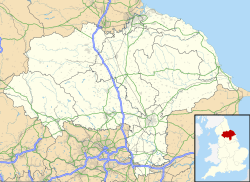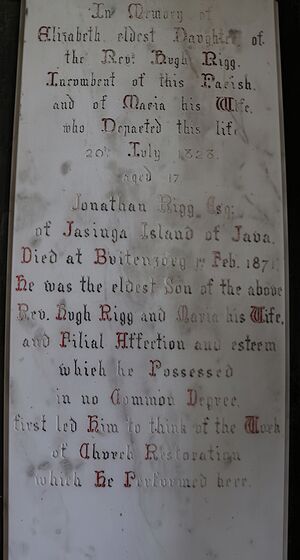Church of St Patrick, Patrick Brompton facts for kids
Quick facts for kids St Patrick's Church |
|
|---|---|
| Church of St Patrick, Patrick Brompton | |

Church of St Patrick, Patrick Brompton
|
|
| 54°18′41″N 1°39′53″W / 54.3114°N 1.6646°W | |
| OS grid reference | SE219907 |
| Location | Patrick Brompton, North Yorkshire |
| Country | England |
| Denomination | Church of England |
| Weekly attendance | 25 (2017) |
| History | |
| Status | Active |
| Dedication | St Patrick |
| Architecture | |
| Style | Early English |
| Specifications | |
| Bells | 3 |
| Administration | |
| Parish | Patrick Brompton (460432) |
| Benefice | Lower Wensleydale |
| Deanery | Wensley |
| Archdeaconry | Richmond and Craven |
| Diocese | Leeds |
The Church of St Patrick is a historic church in the small village of Patrick Brompton in North Yorkshire, England. It serves as the main church for the local area. This church is part of a group of six churches in a region called the Benefice of Lower Wensleydale.
Some parts of the church building are very old, dating back to the 11th century. That's over 900 years ago! The church is about 6 miles (9.7 km) southeast of Richmond and 4 miles (6.4 km) north of Bedale. It sits right by the A684 road. Interestingly, it's one of only two churches in all of Yorkshire named after St Patrick.
Contents
Discovering the Church's Past
The first mention of a church in Patric Brumpton was in the 12th century. However, people believe a place of worship was here even earlier. The church you see today was mostly built between the 12th and 14th centuries. Over the years, it has been changed and added to.
Major Renovations and Funding
In 1864, the church had a big makeover. This project was paid for by Jonathan Rigg. He was the son of the church's leader, Hugh Rigg. Jonathan owned a tea plantation far away in Java, which is now part of Indonesia.
You can find a marble stone inside the church that mentions Jonathan Rigg's help. His initials, JR, are also carved into the stone arch above the main entrance.
Why is it Called St Patrick's?
The church was first called St Patrick's in 1230. It might be named after a landowner from that time called Ghile Patraic. Some people think a carved space in the church used to hold a statue of St Patrick.
Church Design and Materials
The church has a main area called the nave, with two side sections called aisles. At the east end is the chancel, and a small room called a vestry is to the north. There's a porch near the tower at the west end.
Most of the inside of the church is from the 12th century. The outer walls were built in the 14th century. The porch and the tower are newer additions. The church is mostly built from sandstone. Its roof is covered with slates from Westmorland.
The church's design is quite grand for a small village church. This might be because it was supported by St Mary's Abbey in York.
The Church Tower and Bells
The current tower was built in the 19th century. It replaced an older tower from 1577. Before that, there was a tall steeple that was blown down in a storm. The exact date of the steeple's destruction is unclear, with some records saying 1577 and others 1672.
The 19th-century tower has a pyramid-shaped roof. Some people thought this roof didn't look very good with the rest of the church.
The tower holds three bells. They are dated 1400, 1686, and 1703. The bell from 1686 has a Latin message that means "a very little crack caused great ruin." This is thought to refer to the steeple falling down in the 1577 storm.
Ancient Archer Marks
On the outside of the church, at the north-east end, you can still see marks where archers sharpened their arrows. These marks were made between 1100 and 1500. Kings used to order men in every village to practice their archery on holy days. This was so they would be ready to fight if there was a war.
Exploring the Churchyard
The area around the church, called the churchyard, has many old gravestones. Some of these gravestones are considered important historical structures. There is also a special memorial here for the people from the village who died in the First World War. Two graves belong to soldiers from the Commonwealth.
The Historic Sundial
Near the porch door, there's an eight-sided stone column with a sundial on top. It has the name Geoge Smythes, Bedal carved into it. The sundial also mentions Newfoundland and Maryland. People think it remembers villagers who traveled to be settlers in the "New World" (America).
Understanding the Parish
The Church of St Patrick is part of the Benefice of Lower Wensleydale. This group includes six churches. The other five churches are St Andrews Finghall, St Gregory's Crakehall, St Michael Spennithorne, St Oswald's Hauxwell, and St Mary's church in Hornby.
The Parish of Patrick Brompton also includes the nearby villages of Hunton and Newton-le-Willows. In 2017, about 25 people attended the church each week on average. This number was a bit higher in 2008, when it was around 35 people per week.
Church Leaders (Vicars)
Records show that leaders of St Patrick's Church, called vicars, have been serving here since at least 1300.
See also
- Grade I listed buildings in North Yorkshire (district)
- Listed buildings in Patrick Brompton



